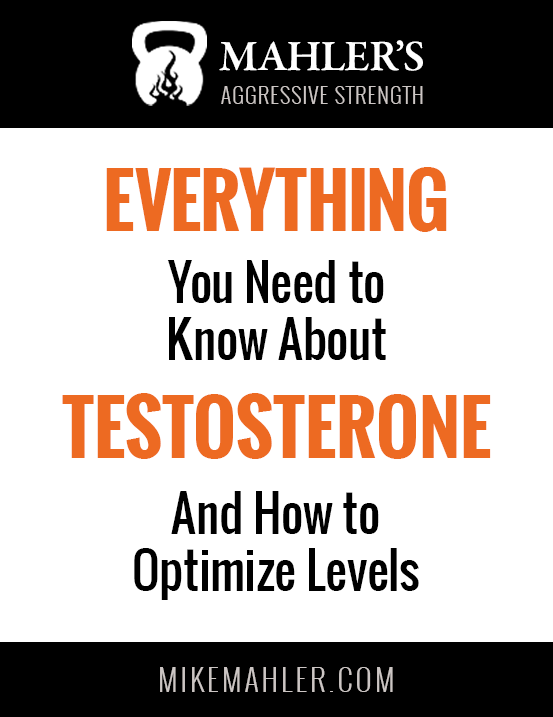My total testosterone levels are pretty high at 775ng/dl but my free testosterone is very low at only 8 pg/ml. What can I do to increase free testosterone levels?
First, if you engage in intense training and didn’t take a few days off to rest before getting your blood drawn, you may have low blood levels of free testosterone due to androgen receptor uptake. I would not be as concerned with low free testosterone levels if you fall into this category and also have a high libido and don’t have any issues with building muscle and strength. Moreover, if you experience spontaneous morning erections daily then your free testosterone levels are likely optimal. However, if your sex drive is low, you are moody and don’t have a strong feeling of genuine confidence then keep reading for advice on increasing free testosterone levels.
One possible explanation for your low free testosterone levels may be too much consumption of fiber. The daily recommendation of around thirty grams of fiber daily is not likely an issue but if you are on a plant-based diet, for example, your fiber intake may be several times higher which can be problematic for optimal free testosterone levels. According to supplement expert and frequent LLA podcast guest Jerry Brainum, a high fiber diet raises levels of sex hormone-binding globulin (SHBG) and excessive levels of SHBG prevent free testosterone from being utilized by androgen receptors. While SHBG functions to transport testosterone in the bloodstream to be utilized at various receptor sites too much SHBG inhibits the utilization of free testosterone.
To calculate the ideal levels of SHBG take a page from Dr. Mark Gordon and add the bottom of the range to the top of the range and divide by two. For example, the normal range of SHBG is 10 to 57 nmol/L, so divide 67 by two and the optimal range is around 33.5 or below. If SHBG is too low it will inhibit transport of testosterone so just like ideal estrogen markers, you don’t want to be too low or too high.
Your total testosterone levels are excellent so I doubt your dietary fat intake is insufficient but just in case make sure to avoid reducing dietary fat intake below 20% of total calories. Personally I like my dietary fat intake to be around 30-40% of overall caloric intake. When my dietary fat intake is too low I experience a negative impact on training performance, sex drive, and mood. If you consume too much fat (over 40% of total caloric intake) you may develop insulin resistance and experience a rise in fasting glucose levels despite limited carbohydrate intake. Too much fat weakens insulin receptors which can cause an increase in blood glucose levels. More than consumption of carbohydrates being the cause of excess glucose levels is too much intake of refined carbohydrates on top of too much intake of dietary fats especially poor quality fats such as transfats.
Make sure to choose fat sources that have the most positive impact on optimal testosterone production such as coconut oil, olive oil, macadamia nuts, almonds, hazelnuts, and pecans. According to Brainum, fat, especially saturated fat found in coconut oil and cacao is involved with cholesterol synthesis in the liver and cholesterol is the building block for all sex hormones including testosterone. Olive oil and coconut oil have been shown to help convert cholesterol into testosterone in the testes as well.
Brainum also conveys that polyunsaturated fat such as what is in vegetable oils, flaxseeds, and hempseed has no impact on testosterone (doesn’t lower or raise) while trans fats definitely lower testosterone levels so avoid those completely as other health complications are also indicated with transfat intake. Also, just because polyunsaturated fats such as flaxseeds and hempseed don’t directly support testosterone production, it doesn’t mean they should be avoided as both have numerous benefits. Hempseeds are high in protein, and testosterone production supporting minerals zinc and magnesium. Flaxseeds help mitigate excess inflammation and also improve the ratio of good to bad estrogens (2 hydroxy estrone to 4 and 16 hydroxy estrone).
Next, make sure your intake of the minerals magnesium, boron, and zinc are adequate. Depleted levels of magnesium, boron, and zinc lower free testosterone levels and getting your magnesium, boron and zinc levels in the optimal range will support ideal free testosterone levels. Hempseeds and pumpkin seeds are excellent sources of magnesium and zinc and apples, potatoes, and legumes are high-quality sources for boron. In addition, all of the herbs in my natural testosterone booster ASTB support both total and free testosterone levels.
Finally, keep in mind your free testosterone levels should account for around 2% of your total testosterone levels. If you have a total testosterone level of 800 ng/dl your free testosterone levels should be at least 16 pg/ml. Again, if you engage in intense training make sure to take a few days off before having free testosterone levels measured for a more accurate reading.
For more information on testosterone and all things nutrition, training, and supplements, make sure to subscribe to Jerry Brainum’s exceptional newsletter at appliedmetabolics.com

